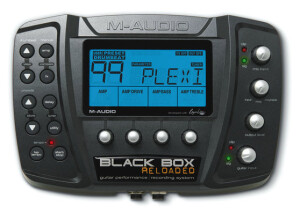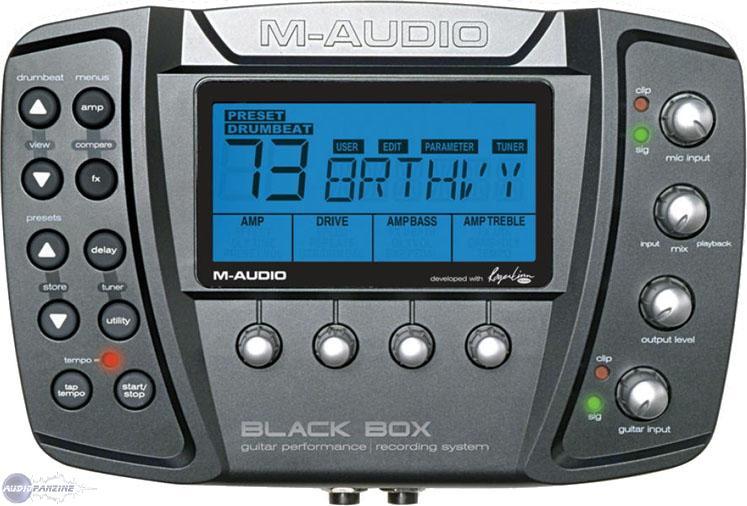View other reviews for this product:
Published on 10/03/06 at 03:58
Warning: once the machine is purchased, if the firmware is version 1, it is indispensable to bring it to version 2. This then allows you access to:
40 models:
• Fender Bassman
• Fender Deluxe Reverb
• Fender Twin
• Fender Deluxe
• Fender Champ
• Marshall JTM-45
• Marshall Plexi Super Lead 100
• Marshall JCM-800
• Marshall JCM-2000
• Vox AC-30
• Vox AC-15
• Roland Jazz Chorus
• Hiwatt DR-103
• Mesa Boogie Mark IIc
• Mesa Boogie Dual Rectifier
• Soldano SLO-100
• Bogner Uberschall
Diezel VH4 •
• ENGL Powerball
• Peavey 5150 MkII
• Bogner Ecstasy
• Budda Twinmaster
• Matchless Chieftain
• Acoustic 360
• Ampeg SVT
• Gallien-Krueger 800RB
• SWR SM-500
121 Effects:
• many effects synchronized to the tempo
• tremolo
• filter tremolo
• auto-pan
• flanger
• chorus
• rotary speaker
• Vibrato
• filter synchronized to the tempo random
• flanger synchronized to the tempo léatoire
• tremolo sequences
• filter sequences
• sequences of arpeggios
• auto wah
• wah
• talk box
• pedal talk box
• Volume swell
• effects science fiction
• MIDI control or filter
+ Reverb + 1 + 1 compressor gate
Drum machine with 100 paterns
Tuner
USB + SPDIF audio connection
Processing 24 bit / 44 kHz
Guitar input + XLR
Stereo output jack pedal inputs + 6.35
UTILIZATION
Simple enough, except for certain functions "secondary" as the mid setting, for example (where you have to first press a button twice to access). Otherwise it remains relatively affordable, which has used a multi-effects.
The manual is fairly clear and well done.
SOUND QUALITY
First, the unnecessary:
- The drum: I do not find much interest. First it is not editable and was then quickly toured the paterns available.
- Some effects of "strange": the random filters or sound "fx" science fiction (!!!)
Second, more than in a simple multi-effect guitar or an amp simulator simple:
- Integrated audio interface: handy when you want to work on the move. It is 24/44 but it's more than enough to record guitar plans. The USB interface works fine and the drivers seem quite stable.
- The XLR input: same as the audio interface, it is convenient for a small mobile use. on the other hand, no phantom power supply on that. The effects can be used on the microphone, which is nice. As against this use is only possible via the USB connection, too bad when we want to use such models to live a harmonica through a dynamic microphone.
Finally, for which I purchased the amp models.
They are generally good to see good quality. The character of the guitar is well respected, the dynamics are good (although it's still modeling), the breath is acceptable, with almost no use of the noise gate (very good with updating firmware This was not the case at all before), the sound is so cold that POD and much more accurate than a V-Amp 2.
In contrast to POD and V-Amp 2, it is not possible to choose the model of the speakers, the latter being directly affected in the original amp model. While this somewhat limits the possibilities, but the models are of good quality and it is ultimately what we fields to search. Do not cherher fidelity compared to the original: you must get into their heads that will never be worth modeling a real amp lamp. The result of the studio recording an amp lamp is in turn dependent on many parameters: micro used, environmentally sound ... it is more difficult to compare.
I use it with my Gibson All American II pickups with 2 singles.
Among my favorites:
- Fender Bassman: well rounded with lots of presence
- Marshall Plexi
- JCM 800 (it allows me to find the sound of my real Marshall)
- Vox AC15: compared to 30, the sound is better defined and more "vintage"
- Roland Jazz Chorus: micro in the neck position, perfect for small jazzy rhythms. The sound is very soft and very well defined
- Hiwatt DR-103: with my two simple configuration, there are a lot Pete Townshend. Well crunchy / rock, I love (talking 'bout my generation)
- Mesa Boogie Dual Rectifier and Soldano SLO-100: it sends the bulk! The breath is "modest" for the simulation. Noise gate compulsory but it is effective and musical (in the version 2 firmware I specify)
- Ampeg SVT: it's true that having more 4 bass amp simulation at hand it does. Testing a Yamaha fretless on this emulation of the famous Ampeg SVT has been very surprising: the sound is well rounded and well defined.
OVERALL OPINION
All in all a very good machine. I bought it primarily as an amp simulator for the home studio and live (solo configuration: I use the power of 2 or 3 pieces in my small set).
Its other functions (including audio interface) are for me the most. They are not negligible and far from me, for example, will avoid investing in another audio interface mobile the day I need it.
The value for money is fairly unbeatable: I have acquired for € 199 at Milonga with the pedal, which is very handy for live. It also helps to control the wah and change presets.
Short compared to my V-Amp 2 that I liked it is still well beyond my expectations. I would do this choice.
40 models:
• Fender Bassman
• Fender Deluxe Reverb
• Fender Twin
• Fender Deluxe
• Fender Champ
• Marshall JTM-45
• Marshall Plexi Super Lead 100
• Marshall JCM-800
• Marshall JCM-2000
• Vox AC-30
• Vox AC-15
• Roland Jazz Chorus
• Hiwatt DR-103
• Mesa Boogie Mark IIc
• Mesa Boogie Dual Rectifier
• Soldano SLO-100
• Bogner Uberschall
Diezel VH4 •
• ENGL Powerball
• Peavey 5150 MkII
• Bogner Ecstasy
• Budda Twinmaster
• Matchless Chieftain
• Acoustic 360
• Ampeg SVT
• Gallien-Krueger 800RB
• SWR SM-500
121 Effects:
• many effects synchronized to the tempo
• tremolo
• filter tremolo
• auto-pan
• flanger
• chorus
• rotary speaker
• Vibrato
• filter synchronized to the tempo random
• flanger synchronized to the tempo léatoire
• tremolo sequences
• filter sequences
• sequences of arpeggios
• auto wah
• wah
• talk box
• pedal talk box
• Volume swell
• effects science fiction
• MIDI control or filter
+ Reverb + 1 + 1 compressor gate
Drum machine with 100 paterns
Tuner
USB + SPDIF audio connection
Processing 24 bit / 44 kHz
Guitar input + XLR
Stereo output jack pedal inputs + 6.35
UTILIZATION
Simple enough, except for certain functions "secondary" as the mid setting, for example (where you have to first press a button twice to access). Otherwise it remains relatively affordable, which has used a multi-effects.
The manual is fairly clear and well done.
SOUND QUALITY
First, the unnecessary:
- The drum: I do not find much interest. First it is not editable and was then quickly toured the paterns available.
- Some effects of "strange": the random filters or sound "fx" science fiction (!!!)
Second, more than in a simple multi-effect guitar or an amp simulator simple:
- Integrated audio interface: handy when you want to work on the move. It is 24/44 but it's more than enough to record guitar plans. The USB interface works fine and the drivers seem quite stable.
- The XLR input: same as the audio interface, it is convenient for a small mobile use. on the other hand, no phantom power supply on that. The effects can be used on the microphone, which is nice. As against this use is only possible via the USB connection, too bad when we want to use such models to live a harmonica through a dynamic microphone.
Finally, for which I purchased the amp models.
They are generally good to see good quality. The character of the guitar is well respected, the dynamics are good (although it's still modeling), the breath is acceptable, with almost no use of the noise gate (very good with updating firmware This was not the case at all before), the sound is so cold that POD and much more accurate than a V-Amp 2.
In contrast to POD and V-Amp 2, it is not possible to choose the model of the speakers, the latter being directly affected in the original amp model. While this somewhat limits the possibilities, but the models are of good quality and it is ultimately what we fields to search. Do not cherher fidelity compared to the original: you must get into their heads that will never be worth modeling a real amp lamp. The result of the studio recording an amp lamp is in turn dependent on many parameters: micro used, environmentally sound ... it is more difficult to compare.
I use it with my Gibson All American II pickups with 2 singles.
Among my favorites:
- Fender Bassman: well rounded with lots of presence
- Marshall Plexi
- JCM 800 (it allows me to find the sound of my real Marshall)
- Vox AC15: compared to 30, the sound is better defined and more "vintage"
- Roland Jazz Chorus: micro in the neck position, perfect for small jazzy rhythms. The sound is very soft and very well defined
- Hiwatt DR-103: with my two simple configuration, there are a lot Pete Townshend. Well crunchy / rock, I love (talking 'bout my generation)
- Mesa Boogie Dual Rectifier and Soldano SLO-100: it sends the bulk! The breath is "modest" for the simulation. Noise gate compulsory but it is effective and musical (in the version 2 firmware I specify)
- Ampeg SVT: it's true that having more 4 bass amp simulation at hand it does. Testing a Yamaha fretless on this emulation of the famous Ampeg SVT has been very surprising: the sound is well rounded and well defined.
OVERALL OPINION
All in all a very good machine. I bought it primarily as an amp simulator for the home studio and live (solo configuration: I use the power of 2 or 3 pieces in my small set).
Its other functions (including audio interface) are for me the most. They are not negligible and far from me, for example, will avoid investing in another audio interface mobile the day I need it.
The value for money is fairly unbeatable: I have acquired for € 199 at Milonga with the pedal, which is very handy for live. It also helps to control the wah and change presets.
Short compared to my V-Amp 2 that I liked it is still well beyond my expectations. I would do this choice.



